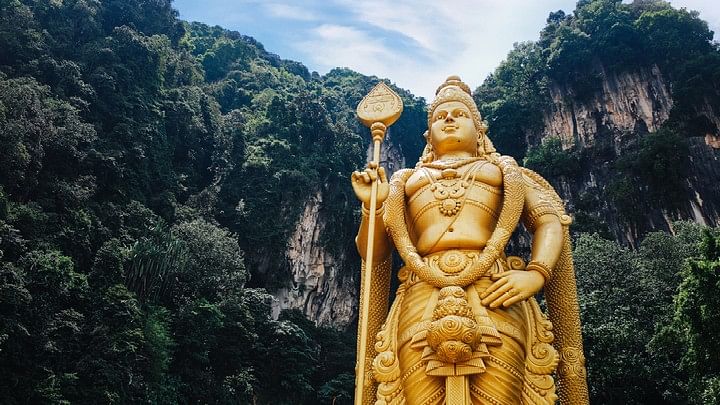
Murugan who lives in the South represents Shiva of the North.
Credit: iStockPhoto
Nowadays two ideas are being pushed by social media intellectuals. First, that mythology is history. Second, that Indian culture needs to decolonise itself from foreign influence. This makes rishi Agastya, a highly-venerated Vedic sage, a problematic figure in South India.
As per mythology, Agastya came to South India from the North with Vedic ideas. That would make Agastya an outsider in the South, and so his ideas would be seen as colonial ideas, as he colonises the South by introducing Vedic ideas. The only way to counter this idea is to say that the land south of the Vindhya mountains was always Aryavarta, and Bharatvarsha, from the dawn of time. Agastya just moved from North Aryavarta to South Aryavarta. He did not introduce Vedic ideas, as Vedic ideas pre-existed Agastya in South India. That Agastya is not to be seen as a fountainhead of Vedic ideas in the South, but, merely as a re-affirmer of Vedic ideas.
This is the story of Agastya’s migration: Shiva, who sits atop Mount Kailasa, located in the Himalayas, once gave a discourse on Veda and Tantra. Seven sages rushed to hear it, causing the earth to tilt northwards. To balance the world, Shiva told Agastya to move to the south. As Agastya went south, Shiva’s consort Shakti told him to carry mountains and rivers from the north to the south. Her son, Kartikeya, had fought with Shiva and moved south. He missed home, and so Shakti wanted to send him the northern landscape.
Agastya carried the rivers in his water pot, and the mountains were carried on a shoulder yoke. Agastya was assisted by Hidimba-rakshasa. This explains why rivers in South India such as Kaveri and Krishna are called Dakshina-Ganga, or southern Ganga, and the mountains of South India are called Dakshina-Kailasa, or southern Kailasa. Agastya is said to be the formulator of Tamil grammar. He is also the source of the South Indian school of Ayurveda, known as the Siddha school, with its distinct love for mercury. When Ram came south, he met Agastya who gave him weapons to fight Ravana, a rakshasa-king whose father was also a rishi who had migrated south and married a rakshasa-woman called Kaikesi.
We are told that there was another reason why Agastya moved South. The Vindhya mountains had grown so tall that he was blocking the movement of the Sun and other celestial bodies. Agastya complained that Vindhya was blocking his movement south. Out of respect, Vindhya bowed helping the sage cross easily. Agastya requested Vindhya not to rise till he returned and so, the mountain remains low even today, connecting the north and the south.
The Vindhyas run east-west, and roughly parallel to the Tropic of Cancer, which marks the latitude from where the Sun begins its southerly course every June. North of this latitude, shadows always fall in the northern direction. To the south, shadows fall southward on some days. This made the South a rather inauspicious zone to Vedic people who lived in the Ganga-Yamuna doab, in the shadow of the Himalayas and Mount Kailasa. This was the original Aryavarta.
On the eastern and western edges of the Tropic of Cancer, we find the rivers Vaitarni — one in Odisha, and one in Maharashtra. Vaitarni is the name of a mythical river mentioned in the Garuda Purana that separates the land of the living from the land of the dead. In Vaastu, the south is the direction of Yama, the god of death. All these ideas suggest a general discomfort with the South. Until Kartikeya’s migration, followed by Agastya’s migration.
In South India, in Karnataka, is the pass which is said to have been created by Kartikeya who hurled a spear and split the Krauncha mountains in two. Kartikeya now lives atop Mount Palani, in Tamil Nadu, said to have one of the peaks brought to the south by Hidimba. Murugan who lives in the South represents Shiva of the North.
Ravana tried to bring Mount Kailasa and numerous shivalingas to the South. His brother Vibhishana brought the image of Perumal Vishnu from Ayodhya to Srirangam. Lanka is said to be located near Mount Trikuta, which is said to be a peak of the Vindhyas carried south, and dropped in the middle of the sea, by the wind-god, Vayu. Are all these metaphors for the South’s colonisation by Vedic people, led by rishis like Agastya?
Agastya drank the water of the sea enabling Devas to kill Asuras. Agastya ate the flesh of a goat served to him by an asura called Atapi. That goat was supposed to be an asura called Vatapi who planned to resurrect himself in Agastya’s stomach and rip the sage’s stomach apart from the inside, but Agastya digested Vatapi before he could do that. Are these stories of conquest of southern kings, who controlled the sea, and who ate meat, whose stories are told in Sangam literature? If mythology is history, if colonisation is evil, and if South India was once not part of Aryavarta, we need to pay attention to these stories.
(Devdutt Pattanaik is the author of more than 50 books on mythology. X: @devduttmyth)
Disclaimer: The views expressed above are the author's own. They do not necessarily reflect the views of DH.